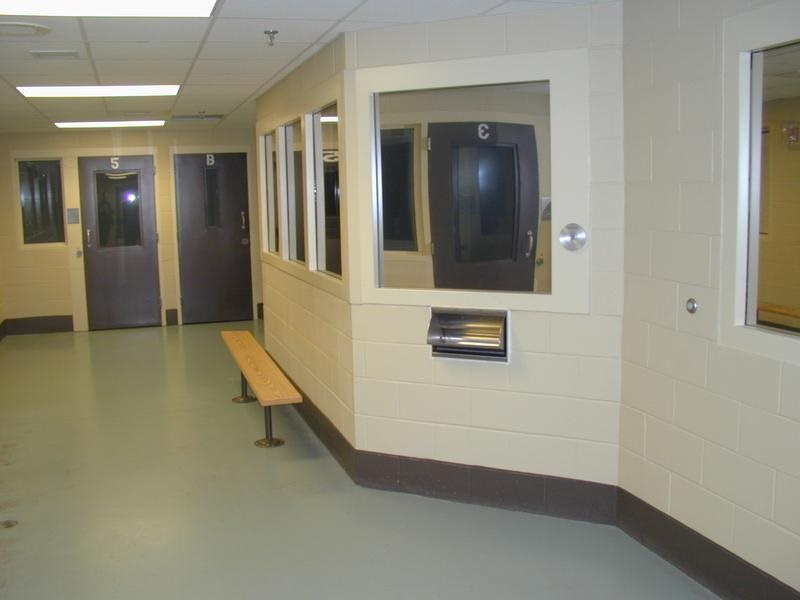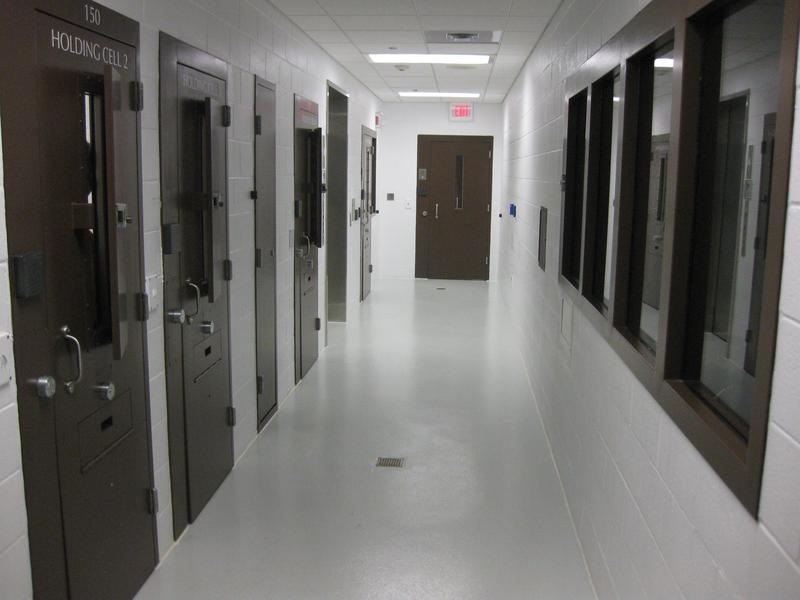Modern courthouses generally have two detention areas: a central holding and staging area for transferring of prisoners to the court floors, and smaller court floor holding areas close to the courtrooms for rapid movement to and from the courtrooms. This page describes the requirements of the central holding area.
 |
|
Central Prisoner Holding Area - Williamsburg-James City County, Virginia |
 |
|
Central Prisoner Holding Area - Isle of Wight, Virginia |
Court facilities in which criminal trials are held should have detention facilities for male and female prisoners. Prisoners should always be kept apart from the court staff and general public. There should be secure holding facilities within the courthouse to temporarily hold prisoners before and after their appearance in court.
Prisoner detention facilities increase the efficiency of the courts by allowing the detainee to be located in close proximity to the courtroom at the scheduled time of appearance. Even in jurisdictions where the jail is adjacent to the courthouse, it may be necessary to design a holding and staging area within the courthouse for securing and transporting prisoners.
For more information about factors influencing the selection of location for court and detention facilities, see also Consolidation or Separation of Judicial and Detention Facilities.
All holding and security areas should be designed to enhance the court’s security functions. The presence of holding areas close to the courtrooms and the location of security stations throughout the facility should be designed so as not to detract from the decorum of the court. Holding cells should have solid ceilings.
The central holding area should consist of the following elements:
- Holding cells for adult males and females
- Holding cells for juvenile males and females
- A control center to monitor and control in-custody movement
- Entry vestibule at the entrance from the sally port
- A processing and transfer area or room
- Staff offices
- Staff toilets
- Elevators to the court floors
- Elevator lobby
- Equipment room
- Attorney / client interview booths for attorneys to meet privately with clients prior to court
State standards should be consulted to determine the required sizes of holding cells, a minimum of 100 to 120 square feet is recommended for group cells for four prisoners. Individual cells for segregating prisoners, should be a minimum of 70 square feet.
The control center monitors the operations of the holding area. The officer manning the station should have a direct view into the holding cells or have visibility through monitors and should be able to monitor or control all entrances and exits. The station should be secured from unauthorized entry and should include a dedicated staff toilet.
Sufficient staging areas for transporting inmates should be provided near the sally port entrance and the secure prisoner elevators. Corridors should be wide enough to prohibit inmates from grabbing officers and to allow adequate two-way passage. There should be separate holding facilities for men and women. If these holding areas are co-located, there should be sight and sound separation between the sexes. Juveniles should not be held in close proximity to adults. If juveniles must be held with adults, additional sight and sound separation is required.
Attorney/client interview booths should be provided at the central holding facility and on the court floors. These booths should be approximately 60 square feet and divided with appropriate security glazing to separate the parties. A small contact conference area of 60 to 80 square feet may also be provided to allow for the review and signing of documents.
The cells should be well ventilated, well lighted, and well maintained. Temporary holding cells for prisoners awaiting court appearances should conform to appropriate state and American Correctional Association standards for lighting, ventilation, heating, and cooling in short-term holding and detention facilities.
Lighting fixtures and ventilation shafts should be secured in place to prevent their removal and use as weapons. The cells should be equipped with vandal-resistant furniture.
It is extremely important that holding areas be soundproofed. Drains for sinks, toilets, and wash drains should be large enough so that they cannot be easily blocked up and cause flooding.
Where separate central holding cells or court floor holding cells are provided for adult male, juvenile male, adult female, or juvenile female, one of each type at each location should be accessible. Where central-holding cells are provided, which are not separated by age or sex, at least one cell shall be accessible. Each accessible cell shall provide an accessible turning space, doors, toilets, lavatories, grab bars, drinking fountain. An exception is allowed for doors operated only by security personnel.
Visiting areas, where provided, shall be located on an accessible route and be accessible. Five percent, but not less than one, of fixed cubicles shall be accessible on both the visitor and detainee sides. Where counters are provided, a portion at least 36 in (915 mm) in length shall be accessible on both the visitor and detainee sides.
In-custody defendants and witnesses need to be separated from the public while maintaining their safety and constitutional rights.
Prisoner detention facilities increase the efficiency of the courts by allowing in-custody persons to be located close to the courtroom at the scheduled time of appearance. All but the smallest courthouse should have a central holding area located on the ground floor or basement of the building that will service all courts within the building. It should be located immediately adjacent to the vehicular sally port.
All passage of prisoners to and from the holding cell and the courtroom should be by a secure corridor that is completely separate from the circulation routes of judges, court staff, and the public. The route should be as direct as possible.
Access to secure corridors should be either by key/card control or through remotely controlled electronic locks. Attorneys should be able to enter the interview booths from the public area without entering the secured area.
Secured corridors should be free from indentation and be monitored by security cameras connected to the control station.
Furnishings should be fixed and rated for maximum security. Lighting fixtures and air-conditioning and ventilating registers should be secured in place to prevent their removal as weapons.
Every cell should have its own toilet facility. This will eliminate the need for staff persons to transport inmates to and from toilets. These facilities may be combined wash basin and toilet units constructed of either stainless steel or porcelain. Toilets and drains should be installed along a wall on the corridor side of the holding facility or along an accessible service duct so that repairs can be made from the outside. Drains are necessary in any cell with toilets. A modesty panel should be provided around the cell toilets to maintain proper privacy.
Floor drains and vents should be properly covered. The holding cells should have solid ceilings. (An example of good ceiling construction is a solid welded ceiling.). Care should be taken that there are no protruding objects or sharp edges in the holding cells.
